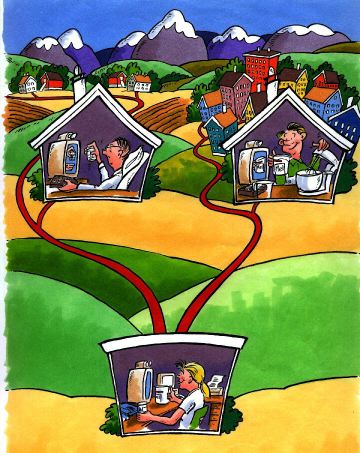

by Jacqueline Floch
Based on the experiences accumulated in the RACE II project Tele Community, SINTEF and the Norwegian company AME (Anvendt Multimedia Elektronikk) are now developing an industrial version of Triasys, a videotelephony-based care service system adapted to the needs of elderly and disabled people. The first release of the system should be installed in the Spring of 1997 in Germany.
Europe has the highest proportion of old people in the world, the number is increasing more than the increase of population as a whole. This leads to a growing need for care services. The costs are escalating and the availability of suitable care personal is not increasing accordingly.
New telecommunication technologies such as ISDN and broadband communication enable innovation in care services. In TeleCommunity, experiments were undertaken in order to evaluate the possibility of using video-communi-cations in care services for elderly and disabled people. Many elderly and disabled people live alone, sometimes isolated and far away from their relatives. A service where these people can contact a service center via videophone is shown to provide a feeling of security and reduce loneliness. Videophone is an improvement over traditional telephone services, as video communication brings a feeling of proximity. In addition to interaction and alarm services, other services may be implemented such as assistance for filling out complex forms and paying bills, or access to expertise on rehabilitation, medical issues or questions related to law, and also remote support for the carers at home. In the Norwegian experiment, the technology was well accepted by the trial users. Several users expressed a need to communicate with friends and relatives. Videotelephony can be a means to engage in a broader range of social integration than traditional telephony.

Concurrent remote collaborative baking and medical hint. (Illustration: Gunnar Bøen)
Triasys is a videotelephony based system which provides communication between a client (usually an elderly or disabled person living at home and requiring care) and a service center. Triasys will be implemented both on ISDN and cable TV networks.
The basic Triasys equipment at the client site consists of a TV set, a camera, a key pad and a control and communication set-top box. TV is used, since most of clients are familiar with and own a TV set. Another advantage of using TV is that no large and cumbersome equipment is introduced in the clients home. Other products similar to Triasys that are available on the market are based on PCs. The potential Triasys customers do not find this to be acceptable.
The keypad is programmable so that control to different functions may be allocated to the customer needs. The keypad is especially designed: it is handy and offers a simple interface. The client may control picture on/off, audio on/off and self view on/off. Additional equipment may be installed at the client site, eg a pan motor coupled to the camera or a document camera. A service center consists of one or more service units (multimedia PCs), a database and possibly additional equipment (eg a document camera). The database contains a description of the equipment and network configuration at each client site, plus other information about the client that is important to the provision of the service (eg telephone number of a relative).
The client equipment can be controlled from the service center units; for instance when giving assistance in reading a medical prescription, the operator can adjust focus on the document camera. Several service centers may be operative in the Triasys system. A client will be connected to a permanent center. However in the case where all operators are busy in this center or in the case of reduced service (eg at night), a client may be transferred to another center. In the future, Triasys will be extended in order to support telebank and teleshopping services. Intelligent home services may also be integrated.
Several ethical issues need to be taken into account when introducing videotelephony based care services. Videotelephony should not be seen as a technical solution that replaces a service provided by humans, but as a means for prolonged independent living. Videotelephony based services should be part of a broader set of services and be used in order to augment personal contacts. It is important that the users themselves desire a videophone based service. An interesting result of TeleCommunity is that the users had less fear at being observed than the researchers expected. Of course a videotelephony based service should let the users decide whether they want to accept a communication, and whether they want to be observed or not.
Several partners are involved in the development of Triasys:
Please contact:
Jacqueline Floch - SINTEF Telecom and Informatics
Tel: +47 73 59 30 12
E-mail: Jacqueline.Floch@informatics.sintef.no